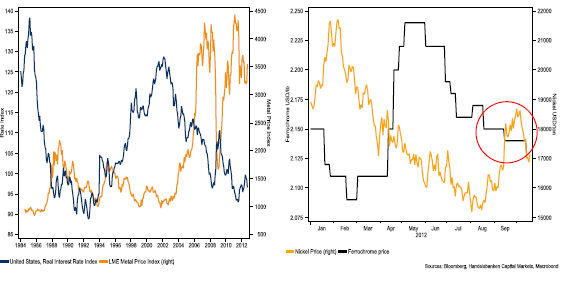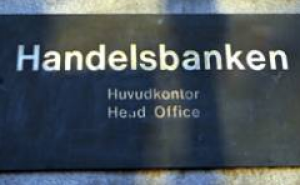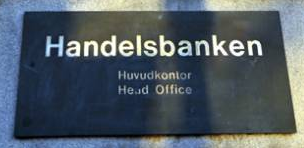Analys
LME Week London 18 oktober 2012
 Hemma efter årets LME-vecka sammanfattar vi diskussioner över middagar och presentationer. 135 år gammal står fortfarande Londons metallbörs för 85 % av handeln med basmetaller och handeln under september månad var den största någonsin. LME veckan är traditionellt metallhandlarnas tid att underhålla sina kunder. Industrin använder LME-veckan som förhandlingsstart för nästa års smält- och rafflöner. Tusentals metallhandlare samlas i London för att träffa industrirepresentanter med förhoppningen att öka förståelsen för vart marknaden ska ta vägen. Sällan har dock koncensus syn på marknaden varit så tight som i år.
Hemma efter årets LME-vecka sammanfattar vi diskussioner över middagar och presentationer. 135 år gammal står fortfarande Londons metallbörs för 85 % av handeln med basmetaller och handeln under september månad var den största någonsin. LME veckan är traditionellt metallhandlarnas tid att underhålla sina kunder. Industrin använder LME-veckan som förhandlingsstart för nästa års smält- och rafflöner. Tusentals metallhandlare samlas i London för att träffa industrirepresentanter med förhoppningen att öka förståelsen för vart marknaden ska ta vägen. Sällan har dock koncensus syn på marknaden varit så tight som i år.
Låga räntor skickar in pengar i metaller vilket gjort att nickel stiger när FeCr faller
Effekterna av lagerhusens köer
Den första lagerfrågan är tillgång till metall från LME:s lager. Frågan var högt på agendan redan förra året men situationen har eskalerat sedan dess. Lagernivåerna för LME metallerna har trendat uppåt under året men simultant har de fysiska premierna (den avgift man får betala ovanpå börspriset för att få ut fysisk metall) stigit. Nuvarande höga premier för zink, aluminium och bly indikerar att tillgången till fysisk metall är begränsad. Kötiden för att få ut metall ur vissa LME-hus är över ett år. Situationen har förvärrats i kölvattnet av QE och Fed policyn att hålla räntorna låga till 2015. Låga räntor gör det extremt billigt att finansiera metall i lager och mycket metall är bunden i finansiella positioner. Synen på hur detta påverkar prisbilden debatterades kraftfullt. LME:s Martin Abbott förekom frågorna med beskedet att man ”tillsatt en utredning” vilket fick mycket ljummen respons.
Låga lager i värdekedjan
Den enskilt viktigaste diskussionen för nästa års prisbild för metallerna var, i våra ögon, lagernivåerna i tillverkningskedjan. Flera rapporter har slagit fast att lagren av metallintensiva varor är höga i Kina men tillgänglig statistik och anekdotiska bevis från de som varit där i närtid tyder på att lagernivåerna är låga efter att ha nått sin topp under 2012 kring det kinesiska nyåret. Detta är speciellt påtagligt för koppar som är den metall som drivs mest av kinas utveckling. Lägre lönsamhet i de kinesiska bolagen och starka intressen att minska arbetande kapital har minskat lagernivåerna i Kina (och Europa) under året. Appropå Kina så diskuterades som vanligt det stundande ledarskapsskiftets inverkan på den kinesiska efterfrågan. Wang Qing från CICC adresserade problemet med kommentaren ”med mindre än en mer avslappnad policy kring fastighetssektorn så kommer återhämtningen att vara svag”
Nästa års smält- och rafflöner
Diskussionen om kommande smält och rafflöner var ursprunget till LME veckan. Numera får dessa diskussioner mycket lite utrymme. Åtminstone bland de finansiella aktörerna. På sidolinjen till konferenserna står dock fortfarande de fysiska aktörerna och diskuterar. Vårt intryck är att både koppar och zink kommer att se högre TC/RC under 2013. För koppar är det kommande överskottet på koncentrat skälet. För zink beror det på att Kina förväntas importera mindre koncentrat i spåren av en inbromsande ekonomi och expanderande gruvproduktion av zinkkoncentrat vilket skapar större överskott i väst samtidigt som de kinesiska smältverken förlorar pengar på nuvarande nivåer och behöver högre smält och rafflöner.
10 % högre TCRC för zink verkar vara koncensus.
Kontentan av årets LME är att alla väntar på vad som ska hända i Kina efter ledarskapsskiftet. De presentationer som gavs var alla slående lika till innehållet; Kina, Eurokrisen och USA:s fiscal cliff dominerade utan att ge något banbrytande på endera tema.
Högst på agendan fanns lagerproblemen
Redan under förra årets LME vecka diskuterades problemet med längre och längre köer för att få ut metall ur LME:s lagerhus. Nu när situationen blivit ännu värre var frågan bland de mest diskuterade. (En industriell aktör säger sig ha fått beskedet att behöva vänta 1 år på att få ut aluminium ur LMEs lagerhus i Detroit). En annan het lagerfråga var de låga lagernivåerna av metall och metallvaror i värdekedjan under 2012. Vidare diskuterades den pågående euforin på finansmarknaden kontra de dystra utsikterna för den fysiska marknaden.
Inbromsningen och ledarskapsskifte i Kina, debaclet i Europa och den ovanligt tysta fysiska marknaden var stående samtalsämnen. Sist men inte minst fick den verkliga huvudfrågan fokus: TC/RC för koppar väntas stiga något under 2013 i spåren av begynnande koncentrat- överskott från stigande gruvproduktion medan zinkgruvor och smältverk verkar stå ganska nära varandra och endast små justeringar uppåt för TC/RC är att vänta för 2013.
Har finansmarknaden prisat in för mycket i metallerna?
Ännu en gång är avvikelsen mellan den fysiska och finansiella marknaden för basmetaller påtaglig, när en svag fysisk marknad står i kontrast till det rally som ägt rum på LME sedan QE annonserades. Fler pengar jagar nu samma tillgångar och en del av QE pengarna söker sig in i basmetaller. Särskilt uppenbart är det på marknaden för rostfritt stål där den finansiellt handlade legeringsmetallen nickel dragit i väg med 10 % under september medan den icke finansiellt handlade krom har fallit i pris.
Analys
Crude oil soon coming to a port near you

Rebounding along with most markets. But concerns over solidity of Gaza peace may also contribute. Brent crude fell 0.8% yesterday to $61.91/b and its lowest close since May this year. This morning it is bouncing up 0.9% to $62.5/b along with a softer USD amid positive sentiment with both equities and industrial metals moving higher. Concerns that the peace in Gaza may be less solid than what one might hope for also yields some support to Brent. Bets on tech stocks are rebounding, defying fears of trade war. Money moving back into markets. Gold continues upwards its strong trend and a softer dollar helps it higher today as well.

US crude & products probably rose 5.6 mb last week (API) versus a normal seasonal decline of 2.4 mb. The US API last night partial and thus indicative data for US oil inventories. Their data indicates that US crude stocks rose 7.4 mb last week, gasoline stocks rose 3.0 mb while Distillate stocks fell 4.8 mb. Altogether an increase in commercial crude and product stocks of 5.6 mb. Commercial US crude and product stocks normally decline by 2.4 mb this time of year. So seasonally adjusted the US inventories rose 8 mb last week according to the indicative numbers by the API. That is a lot. Also, the counter seasonal trend of rising stocks versus normally declining stocks this time of year looks on a solid pace of continuation. If the API is correct then total US crude and product stocks would stand 41 mb higher than one year ago and 6 mb higher than the 2015-19 average. And if we combine this with our knowledge of a sharp increase in production and exports by OPEC(+) and a large increase in oil at sea, then the current trend in US oil inventories looks set to continue. So higher stocks and lower crude oil prices until OPEC(+) switch to cuts. Actual US oil inventory data today at 18:00 CET.
US commercial crude and product stocks rising to 1293 mb in week 41 if last nights indicative numbers from API are correct.

Crude oil soon coming to a port near you. OPEC has lifted production sharply higher this autumn. At the same time demand for oil in the Middle-East has fallen as we have moved out of summer heat and crude oil burn for power for air-conditioning. The Middle-East oil producers have thus been able to lift exports higher on both accounts. Crude oil and condensates on water has shot up by 177 mb since mid-August. This oil is now on its way to ports around the world. And when they arrive, it will likely help to lift stocks onshore higher. That is probably when we will lose the last bit of front-end backwardation the the crude oil curves. That will help to drive the front-month Brent crude oil price down to the $60/b line and revisit the high $50ies/b. Then the eyes will be all back on OPEC+ when they meet in early November and then again in early December.
Crude oil and condensates at sea have moved straight up by 177 mb since mid-August as OPEC(+) has produced more, consumed less and exported more.

Analys
The Mid-East anchor dragging crude oil lower

When it starts to move lower it moves rather quickly. Gaza, China, IEA. Brent crude is down 2.1% today to $62/b after having traded as high as $66.58/b last Thursday and above $70/b in late September. The sell-off follows the truce/peace in Gaze, a flareup in US-China trade and yet another bearish oil outlook from the IEA.

A lasting peace in Gaze could drive crude oil at sea to onshore stocks. A lasting peace in Gaza would probably calm down the Houthis and thus allow more normal shipments of crude oil to sail through the Suez Canal, the Red Sea and out through the Bab-el-Mandeb Strait. Crude oil at sea has risen from 48 mb in April to now 91 mb versus a pre-Covid normal of about 50-60 mb. The rise to 91 mb is probably the result of crude sailing around Africa to be shot to pieces by the Houthis. If sailings were to normalize through the Suez Canal, then it could free up some 40 mb in transit at sea moving onshore into stocks.
The US-China trade conflict is of course bearish for demand if it continues.
Bearish IEA yet again. Getting closer to 2026. Credibility rises. We expect OPEC to cut end of 2025. The bearish monthly report from the IEA is what it is, but the closer we get to 2026, the more likely the IEA is of being ball-park right in its outlook. In its monthly report today the IEA estimates that the need for crude oil from OPEC in 2026 will be 25.4 mb/d versus production by the group in September of 29.1 mb/d. The group thus needs to do some serious cutting at the end of 2025 if it wants to keep the market balanced and avoid inventories from skyrocketing. Given that IEA is correct that is. We do however expect OPEC to implement cuts to avoid a large increase in inventories in Q1-26. The group will probably revert to cuts either at its early December meeting when they discuss production for January or in early January when they discuss production for February. The oil price will likely head yet lower until the group reverts to cuts.
Dubai: The Mid-East anchor dragging crude oil lower. Surplus emerging in Mid-East pricing. Crude oil prices held surprisingly strong all through the summer. A sign and a key source of that strength came from the strength in the front-end backwardation of the Dubai crude oil curve. It held out strong from mid-June and all until late September with an average 1-3mth time-spread premium of $1.8/b from mid-June to end of September. The 1-3mth time-spreads for Brent and WTI however were in steady deterioration from late June while their flat prices probably were held up by the strength coming from the Persian Gulf. Then in late September the strength in the Dubai curve suddenly collapsed. Since the start of October it has been weaker than both the Brent and the WTI curves. The Dubai 1-3mth time-spread now only stands at $0.25/b. The Middle East is now exporting more as it is producing more and also consuming less following elevated summer crude burn for power (Aircon) etc.
The only bear-element missing is a sudden and solid rise in OECD stocks. The only thing that is missing for the bear-case everyone have been waiting for is a solid, visible rise in OECD stocks in general and US oil stocks specifically. So watch out for US API indications tomorrow and official US oil inventories on Thursday.
No sign of any kind of fire-sale of oil from Saudi Arabia yet. To what we can see, Saudi Arabia is not at all struggling to sell its oil. It only lowered its Official Selling Prices (OSPs) to Asia marginally for November. A surplus market + Saudi determination to sell its oil to the market would normally lead to a sharp lowering of Saudi OSPs to Asia. Not yet at least and not for November.
The 5yr contract close to fixed at $68/b. Of importance with respect to how far down oil can/will go. When the oil market moves into a surplus then the spot price starts to trade in a large discount to the 5yr contract. Typically $10-15/b below the 5yr contract on average in bear-years (2009, 2015, 2016, 2020). But the 5yr contract is usually pulled lower as well thus making this approach a moving target. But the 5yr contract price has now been rock solidly been pegged to $68/b since 2022. And in the 2022 bull-year (Brent spot average $99/b), the 5yr contract only went to $72/b on average. If we assume that the same goes for the downside and that 2026 is a bear-year then the 5yr goes to $64/b while the spot is trading at a $10-15/b discount to that. That would imply an average spot price next year of $49-54/b. But that is if OPEC doesn’t revert to cuts and instead keeps production flowing. We think OPEC(+) will trim/cut production as needed into 2026 to prevent a huge build-up in global oil stocks and a crash in prices. But for now we are still heading lower. Into the $50ies/b.
Analys
More weakness and lower price levels ahead, but the world won’t drown in oil in 2026

Some rebound but not much. Brent crude rebounded 1.5% yesterday to $65.47/b. This morning it is inching 0.2% up to $65.6/b. The lowest close last week was on Thursday at $64.11/b.

The curve structure is almost as week as it was before the weekend. The rebound we now have gotten post the message from OPEC+ over the weekend is to a large degree a rebound along the curve rather than much strengthening at the front-end of the curve. That part of the curve structure is almost as weak as it was last Thursday.
We are still on a weakening path. The message from OPEC+ over the weekend was we are still on a weakening path with rising supply from the group. It is just not as rapidly weakening as was feared ahead of the weekend when a quota hike of 500 kb/d/mth for November was discussed.
The Brent curve is on its way to full contango with Brent dipping into the $50ies/b. Thus the ongoing weakening we have had in the crude curve since the start of the year, and especially since early June, will continue until the Brent crude oil forward curve is in full contango along with visibly rising US and OECD oil inventories. The front-month Brent contract will then flip down towards the $60/b-line and below into the $50ies/b.
At what point will OPEC+ turn to cuts? The big question then becomes: When will OPEC+ turn around to make some cuts? At what (price) point will they choose to stabilize the market? Because for sure they will. Higher oil inventories, some more shedding of drilling rigs in US shale and Brent into the 50ies somewhere is probably where the group will step in.
There is nothing we have seen from the group so far which indicates that they will close their eyes, let the world drown in oil and the oil price crash to $40/b or below.
The message from OPEC+ is also about balance and stability. The world won’t drown in oil in 2026. The message from the group as far as we manage to interpret it is twofold: 1) Taking back market share which requires a lower price for non-OPEC+ to back off a bit, and 2) Oil market stability and balance. It is not just about 1. Thus fretting about how we are all going to drown in oil in 2026 is totally off the mark by just focusing on point 1.
When to buy cal 2026? Before Christmas when Brent hits $55/b and before OPEC+ holds its last meeting of the year which is likely to be in early December.
Brent crude oil prices have rebounded a bit along the forward curve. Not much strengthening in the structure of the curve. The front-end backwardation is not much stronger today than on its weakest level so far this year which was on Thursday last week.

The front-end backwardation fell to its weakest level so far this year on Thursday last week. A slight pickup yesterday and today, but still very close to the weakest year to date. More oil from OPEC+ in the coming months and softer demand and rising inventories. We are heading for yet softer levels.

-

 Nyheter3 veckor sedan
Nyheter3 veckor sedanOPEC+ missar produktionsmål, stöder oljepriserna
-

 Nyheter4 veckor sedan
Nyheter4 veckor sedanEtt samtal om guld, olja, fjärrvärme och förnybar energi
-

 Nyheter2 veckor sedan
Nyheter2 veckor sedanGoldman Sachs höjer prognosen för guld, tror priset når 4900 USD
-

 Nyheter2 veckor sedan
Nyheter2 veckor sedanGuld nära 4000 USD och silver 50 USD, därför kan de fortsätta stiga
-

 Analys3 veckor sedan
Analys3 veckor sedanAre Ukraine’s attacks on Russian energy infrastructure working?
-

 Nyheter2 veckor sedan
Nyheter2 veckor sedanBlykalla och amerikanska Oklo inleder ett samarbete
-

 Nyheter4 veckor sedan
Nyheter4 veckor sedanGuldpriset uppe på nya höjder, nu 3750 USD
-

 Nyheter2 veckor sedan
Nyheter2 veckor sedanEtt samtal om guld, olja, koppar och stål










